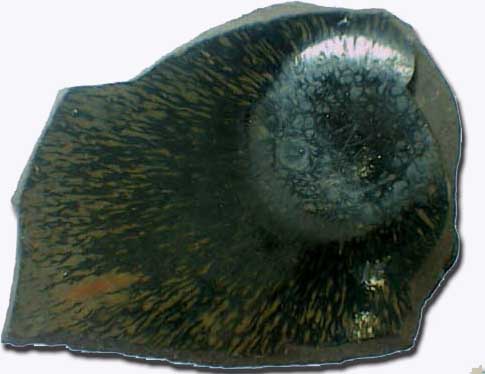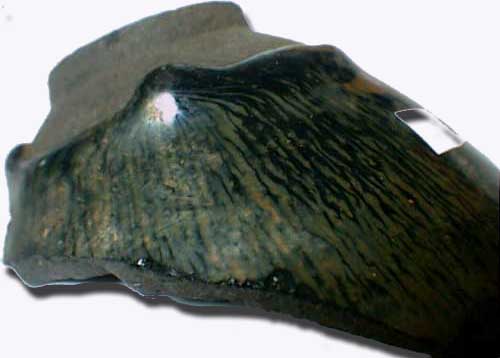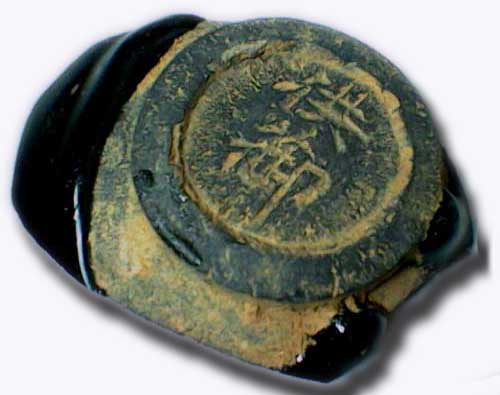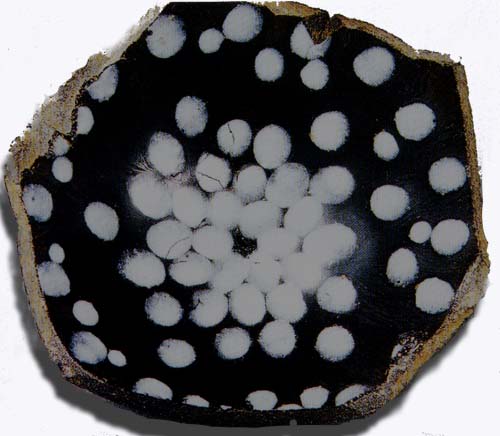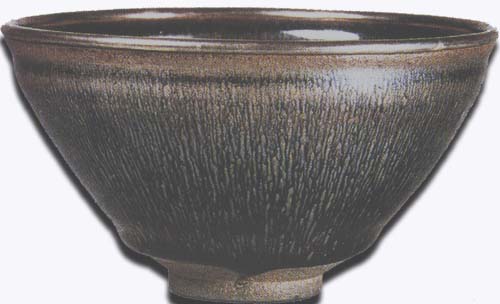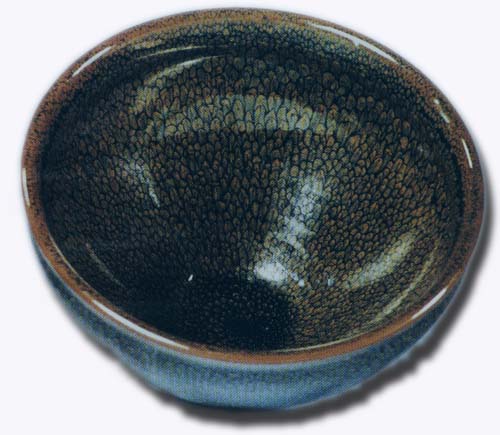|
Many years ago, there appeared in the antique market a great quantity of hare’s fur and oil spot bowls said to be the Song dynasty Jian wares from the Fujian province of China. Basically, these are the black glaze ceramic bowls which were well liked by the Song dynasty emperor for the streaks of the fur like or shiny spot glaze pattern over the body. The artistic appearance cast an enthralling and appealing spell on many of the scholars and court officers during the period of time. It was then a prevailing past time among these intellectuals that they liked to gather and drink tea while discussing national issues or literature works. The tea was in the form of a biscuit and must be grounded into powder form before pouring in the boiling water to brew. As the tea is light in colour, it suits the black bowls as the dark color of the glaze made them specially visible for the tea testing competition which were in fashion in the Song period. The rule of the game is to see whose tea would first stain the edge of the mouth rim at the inner side of the bowl when cooling and whoever had their cup stained the largest number of the water marks in the form of white lines would be the champ. The tea testing contest activity was then rife. That boosted the demand for black glaze bowls . The mass production of such black bowls from Fujian met the need in time, and the beauty of the glaze pattern turned them into object d’ art and a popular collectible that were kept as heir loom or family and passed down for generations. When the price of hare fur bowls has escalated for its investment value, especially when they have become the favorite of the Japanese, which they name as Temmoku, the unscrupulous traders commissione the prodduction of fake pieces for purpose of profiteering. In the early eighties, the smugglers from Macau transported a great quantity of such bowls for sale. They only released some of these pieces and reaped great profit in the beginning. When the market was saturated, they released some more at a lower price. For later batches, the price dropped to only one tenth of the original price at only fifty Singapore dollars each. The Macau traders then revealed to me that these were all imitations made in Fujian. One of the characteristics of Jian wares is that, when we knock the body with our finger lightly, the sound is dull and unclear. They would hence immerse the newly produced potted bowls in a pot of lard and broil it slowly to a certain temperature to break up the clay substance. By so doing, the knocking sound would be dampened to fool the prospective buyers. I took up a piece and put it near to my nose. Sure enough, there emitted a strong lard odor. I read through some scientific research books, and to my surprise, even the experts admitted that the glaze structure of the old and newly made hare’s fur bowls are totally identical and can not be distinguished from each other even under the microscope. A few years ago,
I had a chance to go to Jian Yang, the county where the jian wares were
originated, to attend a seminar and take a learning trip to the kiln site.
I collected quite a lot of shards and conducted a thorough study with the
help of the local collectors and potters. I discovered that there are some
significant differences which we can tell with our naked eyes between a
fake and a genuine jian ware.
We can see that at the bottom just slightly above the foot rim, there is a shallow ridge which was hand thrown as a means to stop the fluidic glaze from overflowing to the foot. As such, we can see beads of glaze accumulated just above this ridge. We call these beads the weeping beads and usually this does not appear in the fakes (there are however some exceptions). The clay is purplish black due to the high content of the iron in the body. We also can find hardened soil remnant stuck very tightly to the body that we can only remove it with the use of a metal tool to scrape it off. If the soil particles appear to be soft and loosely held against the glaze, it would indicate that the piece is possibly a modern production. This is a common practice that the trickster could have glued the soil paste on the surface to feign the old appearance. We tilt a real Jian ware
piece and look at the surface closely under the sun light at an angle,
we also can find cob web like mucus membrane in patches all over the body
which were formed over a few hundred years as a result of chemical reaction
between the glaze and the minerals dissolved in the moisture of the
earth where the jian wares were buried.
There is no exception that all the foot rim of Jian wares are solid, finely crafted, regular and round with a well shaped and depressed base. However, the foot rim of the fakes are usually uneven or crooked. In Jian wares, the most famous and rarest kind of it is the “Yao Bian” or kiln transmutation glaze bowls where the body is covered with brilliant golden spots outlined with rings in the shade of blue color. So far, only four of such pieces found, two in Japan, one each in United Kingdom and China. There are also the gold hare fur, silver hare fur, and yellow hare fur patterns or the oil spots of the different colors as described above. The missing link here is the partridge patches tea bowls with ornamental markings like the mottling and spots on the breast of a partridge, a common bird found in the farms of China. Till this date, we have only discovered the shards of this pattern but a complete piece of it has yet to be found. This casts a doubt as to whether any such partridge patches pattern bowl was really in existence. There are also half fakes
where by the bowls are genuine, but as the glaze were badly corroded or
damaged, the potter hence applied a new layer of glaze and have them go
through another firing in the kiln. As the modern
It is also a misconception that the antique Jian bowls are heavier than the new fakes. To the contrary, the old piece should be lighter as the clay materials were loosely squeezed with the use of bare hands or simple tools to form the shape, when the modern pieces were pressed evenly with the use of an electrically operated throwing machine. The clay particles in the old piece have a lot of space in between which explains their being light in weight, and contributes to its dull sound when being knocked. The Jian bowls are really
befitting to the hold of our hands as what it was originally meant for
use as a drinking utensil, and we should always make the attempts
to use this “hand feeling” method to test an antique ceramic as a important
way to identify the good pieces in our authentication effort.
So hope that now you are
equipped with the knowledge of Jian ware, you may visit an antique shop
to try your luck and acquire a cheap and good Jian ware or temmoku bowls.
Happy collecting!
Written
by: Lim Yah Chiew
|
